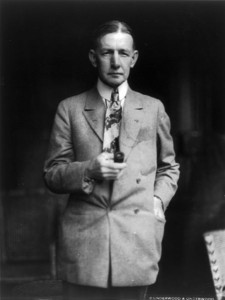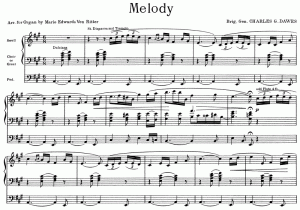by Jack El-Hai, Wonders & Marvels contributor
Barry Manilow, Van Morrison, the Four Tops, Cass Elliot, Isaac Hayes, Bing Crosby and Nat “King” Cole all owe a lot to a now obscure United States vice president and Nobel Peace Prize winner named Charles Dawes. Those musical artists, as well as dozens of others, recorded a song that the American statesman dashed off in a single sitting decades earlier. Dawes, who had a background in banking and law with no formal music training, never suspected that his tune would someday reach the very top of the pop charts in the U.S. and U.K.
The tale of that hit song, “It’s All in the Game,” begins in Marietta, Ohio, where Dawes was born in 1865. Long interested in music but discouraged by his parents from pursuing it as a profession, he taught himself passable skills in playing the piano and flute. He passionately attended concerts of visiting artists in Marietta and kept a diary of his impressions of their performances. Dawes eventually established himself as a banker in Illinois, but he never lost his love of music, helped form the Chicago Grand Opera company, and frequently sat at the keyboard to pass his idle minutes.
During one of those interludes at the piano in 1911, Dawes sketched out a tune that he liked very much. He soon returned to the piece and gave it a solo part for violin. His friend, the violinist and fellow Mariettan Francis MacMillan, heard the melody and fell in love. “It’s just a tune that I got in my head, so I set it down,” Dawes explained to MacMillan. “I never gave the thing a name. If you want it you can have it. It has served its purpose as a diversion for me.”
MacMillan made the most of that invitation. He sold it to a publisher, and before long Dawes’ piece, now titled Melody in A Major, was a light-classical hit. “I was walking down State Street and came to a music shop,” Dawes wrote of his discovery of the fame of his creation. “I saw a poster size picture of myself, my name plastered all over the window in large letters and the window space entirely filled with the sheet music.” Phonograph recordings by such artists as the violinist Fritz Kreisler sold by the tens of thousand.
In the years that followed, as Dawes became the first director of the U.S. Bureau of the Budget, formulated a plan for Germany’s payment of reparations to the Allies, was elected vice president on the Republican ticket with Calvin Coolidge in 1924, and shared a Nobel Peace Prize in 1925 for his work enabling Germany to handle its weighty war reparations, the Melody in A tailed its creator in performances by marching bands, string quartets, and a variety of often ill-fitting musical ensembles. Dawes grew weary of it. “If it had not been fairly good music I should have been subjected to unlimited ridicule,” he lamented.
The cacophony had quieted by the time Dawes died in 1951. Later that year, however, Melody in A began a new life as a hit pop song. Songwriter Carl Sigman — who would later write lyrics for “What Now My Love,” “A Day in the Life of a Fool,” and “Ebb Tide,” — got the tune stuck in his head and adapted it for “It’s All in the Game,” a song about the vicissitudes of love. When crooner Tommy Edwards recorded it first, the song climbed to eighteen on the pop charts. Edwards covered the song again in 1958, and this doo-wop version hit number one and became one of the defining songs of the 1950s. Recordings by a slew of pop, soul, jazz, R & B, and easy-listening artists followed and have continued unabated.
Dawes is the only U.S. vice president and Nobel prize winner to earn a credit for a hit song. At the end of his life he had at last given up on music. “Not long ago I tried to play ‘Tea for Two,’ which I used to play a lot,” he wrote, “but I won’t try it again.” He could no longer hear the musical overtones.
Sources:
Timmons, Bascom N. Portrait of an American: Charles G. Dawes. Henry Holt and Company, 1953.
Was, David. “Tracing the History of a Song: ‘It’s All in the Game.’” Day to Day program transcript, April 5, 2006.


